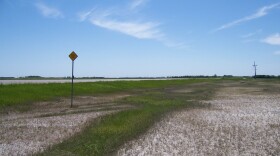Sharp-tailed grouse season opens up on September 14. To quote Morris Johnson and Joseph Knue from their Feathers from the Prairie (1989), “no other upland bird has been in the state so long or in such numbers.”
Sharp-tailed grouse resemble a one to two pound barred brown or buff colored chicken with a small crest. They are typically darker above and lighter below, with a rather short but pointed tail. During the breeding season the males have a purple skin patch on the neck for courtship, along with a yellow eyebrow. And a closer look at their feet will reveal small fleshy projections on each side of their toes. These structures function like little snowshoes, enabling the birds to more easily walk over snow during the winter.
Sharp-tailed grouse feed on a variety of seeds, fruits, acorns, grains, sunflowers, and the buds of plants as well as insects such as grasshoppers and crickets. Their nest is often located in and around brushy cover such as western snowberry and consists of vegetation in a slight depression. If all goes well, one brood will be produced from nine to a dozen eggs.
The sharp-tailed grouse is a species of the mixed grass prairie. They are permanent residents in a range that is roughly the Dakotas and Nebraska westward to the Rocky Mountains and then northward into the southern half of the Canadian prairie provinces where they prefer areas that support scattered patches of shrubs or small trees such as western snowberry, rose, and willows
It should be noted that a few prairie chickens or pinnated grouse may be found in the Sheyenne National Grasslands and Grand Forks County. This close relative is a species of the tallgrass prairie. According to Robert Stewart’s Breeding Birds of North Dakota the prairie chicken apparently did not inhabit what is now North Dakota until the 1870’s when it expanded into the state along with the settlement. The two species do hybridize which creates a bit of a dilemma for wildlife managers.
As with many other wildlife species, preservation of their habitat, in this case native prairie, is key to securing the future for this important game bird. Native prairie continues to be lost to other land uses, but prairie restorations and the Conservation Reserve Program have helped.





